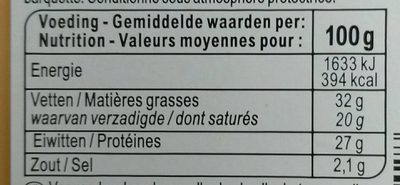Gouda Holland - Carrefour - 300 g
This product page is not complete. You can help to complete it by editing it and adding more data from the photos we have, or by taking more photos using the app for Android or iPhone/iPad. Thank you!
×
Some of the data for this product has been provided directly by the manufacturer Carrefour.
Barcode: 3560070799428 (EAN / EAN-13)
Common name: Gouda Holland, Indication Géographique Protégée, mi-vieux.
Quantity: 300 g
Brands: Carrefour
Categories: Dairies, Fermented foods, Fermented milk products, Cheeses, Cow cheeses, Uncooked pressed cheeses, Cheeses of the Netherlands, Gouda, Gouda Holland
Labels, certifications, awards:
PGI
Origin of the product and/or its ingredients: Conformément à l'IGP, ce Gouda Holland IGP mi-vieux est fabriqué aux Pays-Bas avec du lait origine Pays-Bas.
Producer: Fabriqué aux Pays-Bas puis conditionné par Vergeer Holland, P.O. box 2 - 2810 AA Reeuwijk, Pays-Bas pour Interdis
Traceability code: NL Z 0507 EG
Stores: Carrefour
Countries where sold: France
Matching with your preferences
Environment
Carbon footprint
Packaging
Transportation
Other information
Other information: 300g e IGP Mi-vieux Portion
Conservation conditions: A consommer de préférence avant le :voir la date ci-contre. A conserver entre +2°C et +7°C. A consommer rapidement après ouverture et bien refermer le film de la barquette. Conditionné sous atmosphère protectrice.
Customer service: Interdis - TSA 91431 - 91343 MASSY Cedex - France
Report a problem
Data sources
Product added on by kiliweb
Last edit of product page on by ecoscore-impact-estimator.
Product page also edited by carrefour, openfoodfacts-contributors, org-carrefour, quechoisir, yuka.ZUtFclA3Z1ByT1FIdU05aHpEN1cwTjBxMjV2NGNVRHVML1F3SVE9PQ.










